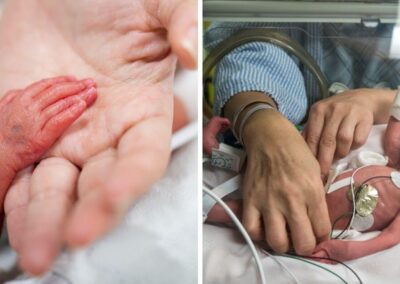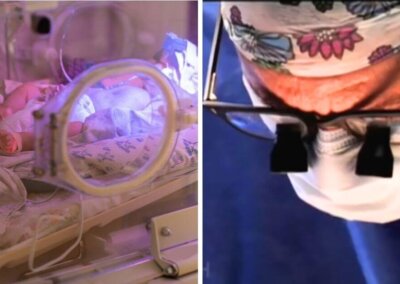A baby girl who was born the size of a Barbie doll is finally going home after spending nearly five months in hospital.
Shyne Graham was born prematurely at 24 weeks and 3 days by emergency caesarean section. She weighed just 1 pound 11 ounces.
Her mother Phaebe Turner had had a miscarriage around Mother’s Day in 2022, and was expecting Shyne around Mother’s Day as well. However, she began bleeding and contracting several months before her due date.
“I remember waking up from surgery in a fog, and people were saying, ‘Congratulations.’ I said, ‘For what?’” she said. “I was shell shocked”.
Phaebe was not able to hold her daughter for two months
Shyne had to breathe through a tube in hospital, and over her stay battled three infections, including strep throat and E. coli.
“It was hard,” Phaebe said. “I’d cry in the car or I’d cry in the bathroom [at the NICU] but not by her side”.
“She was so small. Her hand was the size of my thumb”, she added.
However, Shyne was able to fight off the infections and grew to 10 pounds during her six-month stay in the neonatal intensive care unit (NICU). When she was discharged from hospital, NICU nurse manager LaShon Pitter set up a graduation for Shyne, in which “Pomp and Circumstance” was played as she was pushed out of the front doors in her pram.
The nurse manager said “It was blood, sweat and tears making sure she was OK. Making sure she would survive whatever situation she was going through”.
“I want to walk around the block with Shyne in the sunshine and can’t wait to see her in a stroller and car seat”, her mother said.
“Just to see those babies that start off like as small as your hand and now are normal size babies…it’s amazing”, Pitter said.
It has been over 30 years since the time limit for abortion was last updated
Shyne was born at just over 24 weeks, the current UK abortion limit. The time limit of 24 weeks for abortions performed under section 1(1)(a) of the Abortion Act 1967, was introduced by section 37 of the Human Fertilisation and Embryology Act 1990.
Prior to this change, the abortion limit had, de facto, been 28 weeks gestation set by the Infant Life (Preservation) Act 1929, which made it illegal to “destroy the life of a child capable of being born alive”.
The introduction of a 24-week gestational limit in 1990 was significantly motivated by the results of a Royal College of Obstetricians and Gynaecologists (RCOG) working party report on neonatal survival rates, which noted improvements in survival rates before 28 weeks of gestation.
During the debates ahead of the Human Fertilisation and Embryology Act 1990 becoming law, MPs referred to medical advances that had led to improved neonatal survival rates before 28 weeks gestation and the need for a reduction from 28 weeks.
Similarly, when the question of abortion time limits was revisited in 2008, the lowering of the abortion time limit in 1990 was again linked to the increased survival rates for babies born before 28 weeks gestation.
Spokesperson for Right To Life UK, Catherine Robinson, said “How amazing that baby Shyne was able to grow from 1 pound 11 ounces to a healthy weight of 10 pounds after staying nearly five months in hospital. Stories like these demonstrate how modern medicine can help these tiniest babies make amazing progress, and babies of 24 weeks are no longer the youngest who can be helped by medical technology”.












